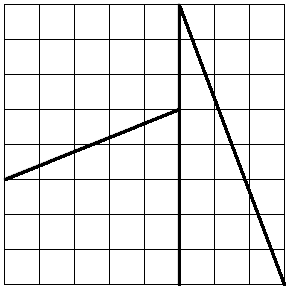
David Hagen offered this puzzle in MIT Technology Review in 2007. The MIT logo can be thought of as a slider puzzle. In the figure above, can you slide the tiles about so that the gray I can escape through the opening at top left?

David Hagen offered this puzzle in MIT Technology Review in 2007. The MIT logo can be thought of as a slider puzzle. In the figure above, can you slide the tiles about so that the gray I can escape through the opening at top left?
https://www.youtube.com/watch?v=IUFYSWh2RqE
The Ironman Heavymetalweight wrestling championship operates under 24/7 rules, meaning that the titleholder must defend it at all times against all comers. This has bred some chaos, with the belt changing hands more than 1,170 times. English wrestler Laura James won the belt in June and lost it the same day to her cat, Bunny (above). Other notable winners:
Heroically, the belt itself became the 1,000th champion. Sanshiro Takagi, the 999th titleholder, was attempting to retire when Poison Sawada knocked him out with the belt, which fell on his chest, “pinning” him. The referee counted him out.

Here’s a triangle, ABC, and an arbitrary point, D, in its interior. How can we prove that AD + DB < AC + CB?
The fact seems obvious, but when the problem is presented on its own, outside of a textbook or some course of study, we have no hint as to what technique to use to prove it. Construct an equation? Apply the Pythagorean theorem?
“The issue is more serious than it first appears,” write Zbigniew Michalewicz and David B. Fogel in How to Solve It (2000). “We have given this very problem to many people, including undergraduate and graduate students, and even full professors in mathematics, engineering, or computer science. Fewer than five percent of them solved this problem within an hour, many of them required several hours, and we witnessed some failures as well.”
Here’s a dismaying hint: Michalewicz and Fogel found the problem in a math text for fifth graders in the United States. What’s the answer?

Is it unjust to adopt a constitution that binds both ourselves and future members of our society? We need a set of fundamental laws to regulate ourselves, but is it fair to extend that to future citizens? Shouldn’t they have the right to choose their own rules?
Thomas Jefferson thought so. In a 1789 letter to James Madison, he held that “the earth belongs in usufruct to the living”: He thought a constitution (or any law) should expire automatically when succeeding generations make up a majority of the population. “The constitution and the laws of their predecessors extinguished … in their natural course with those who gave them being,” he wrote. “This could preserve that being till it ceased to be itself, and no longer. … If it be enforced longer, it is an act of force, and not of right.”
There’s a tension here: In order for a constitution to be successful, it has to define the organization of its society and the freedoms of its citizens, and these rules need to remain in effect for at least several generations in order to produce a healthy liberal democracy. “But those born under a perpetual constitution are expected to acquiesce to the foundational norms approved by their predecessors with neither their consent nor their participation,” writes McGill University political philosopher Víctor M. Muñiz-Fraticelli. “If a constitution is discussed, negotiated, and approved by citizens who are, necessarily, contemporaries, what normatively binding force does it retain for future generations who took no part in its discussion, negotiation, or approval?”
(Víctor M. Muñiz-Fraticelli, “The Problem of a Perpetual Constitution,” in Axel Gosseries and Lukas H. Meyer, eds., Intergenerational Justice, 2009.)

This square of 8 × 8 = 64 square units can apparently be reassembled into a rectangle of 5 × 13 = 65 square units:

This paradox is described in W.W. Rouse Ball’s 1892 Mathematical Recreations and Essays; it seems to have been published first in 1868 in Zeitschrift für Mathematik und Physik.
In 1938 the Rockefeller Foundation’s Warren Weaver discovered an old trove of papers from the 1890s in which Lewis Carroll puzzled out the dimensions of all possible squares in which this illusion is possible (the other sizes include squares of 21 and 55 units on a side).
Regardless of publication, it’s not clear who first came up with the idea. Sam Loyd claimed to have presented it to the American Chess Congress in 1858. That would be interesting, as it was his son who later discovered that the four pieces can be assembled into a figure of 63 squares:

(Warren Weaver, “Lewis Carroll and a Geometrical Paradox,” American Mathematical Monthly 45:4 [April 1938], 234-236.)

Australia was named before it was discovered. Ancient geographers had supposed that land in the north must be balanced by land in the south — Aristotle had written, “there must be a region bearing the same relation to the southern pole as the place we live in bears to our pole” — and Romans told legends of a Terra Australis Incognita, an “unknown land of the South,” more than a millennium before Europeans first sighted the continent.
In 1814 the British explorer Matthew Flinders suggested applying the speculative name, Terra Australis, to the actual place — and in a footnote he wrote, “Had I permitted myself any innovation on the original term, it would have been to convert it to AUSTRALIA; as being more agreeable to the ear, and an assimilation to the names of the other great portions of the earth.”

In 1912, bookseller Wilfrid Voynich discovered an illustrated manuscript that was written in a mysterious alphabet that had never been seen before. The text bears the hallmarks of natural language, but no one has ever been able to determine its meaning. In this week’s episode of the Futility Closet podcast we’ll learn about the Voynich manuscript, which has been bewildering scholars for more than a century.
We’ll also ponder some parliamentary hostages and puzzle over a tormenting acquisition.

In the chalky soil under the English seaside town of Margate, someone has hewn an artificial cave and lined it with millions of seashells. No one knows who, when, or why — the popular story is that a laborer was digging in a field in 1835 when his spade disappeared into a void. Alerted to this mystery, James Newlove, the master of the nearby Dane House School, lowered his son Joshua into the darkness bearing a candle. Joshua would have found himself in a domed rotunda lined with shells, beyond which a winding passageway leads to a rectangular chamber of uncertain purpose. Newlove later purchased the land, installed gas lighting, and opened them to the public.
Even then the origins of the grotto were a mystery — and, as no scientific dating has been undertaken, we still don’t know when it was created. R.F. LeGear, who made an assessment for the Kent Archaeological Society, wrote, “Whoever commissioned and/or planned the elaborate designs for the shell panels must have been a well educated person who managed to entwine many different themes into the intricate patterns of literally millions of shells.” He suspects that a medieval denehole, or chalk-mining shaft, was reworked and expanded in the 17th or 18th century.
But “[a]s to the purpose of this enigmatic structure the writer can make no useful comment except that it is highly likely that the Shell Grotto’s original designer, whoever and whenever that was, has accomplished exactly what he set out to achieve i.e., speculation, controversy and conjecture which started with the discovery in 1835 and continues to the present day.”

(Thanks, Ron.)
Lee Sallows has been working on a new experiment in self-reference that he calls self-descriptive squares, arrays of numbers that inventory their own contents. Here’s an example of a 4×4 square:

The sums of the rows and columns are listed to the right and below the square. These sums also tally the number of times that each row’s rightmost entry, or each column’s lowermost entry, appears in the square. So, for example, the sum of the top row is 3, and that row’s rightmost entry is 1; correspondingly, the number 1 appears three times in the square. Likewise, the sum of the rightmost column is 2, and the lowermost entry in that column, 4, appears twice in the square.
In this example this property extends to the diagonals — and, pleasingly, each sum applies to both ends of its diagonal. The northwest-southeast diagonal totals 2, and both -2 and 4 appear twice in the square. And the southwest-northeast diagonal totals 3, and both 1 and 0 appear three times.
“Easy to understand, but not so easy to produce!” he writes. “I’m still in the throes of figuring out the surprisingly complicated theory of such squares. It turns out there are just two basic squares of 3×3. One of them can be found at the centre of this 5×5 example, which is therefore a concentric self-descriptive square:”

(Thanks, Lee.)

“Eight complete perfect dovetail shuffles, breaking pack exactly in center; that is, cutting off just 26 cards each time and dropping cards from each half alternately, brings the pack to its original order.”
— T. Nelson Downs, in a letter to fellow magician Edward G. “Tex” McGuire, 1923
11/14/2016 UPDATE: Sid Hollander and Harold VanAken sent this demonstration:

Here’s what it looks like in the hands of a skilled shuffler (thanks to reader Sascha Müller):